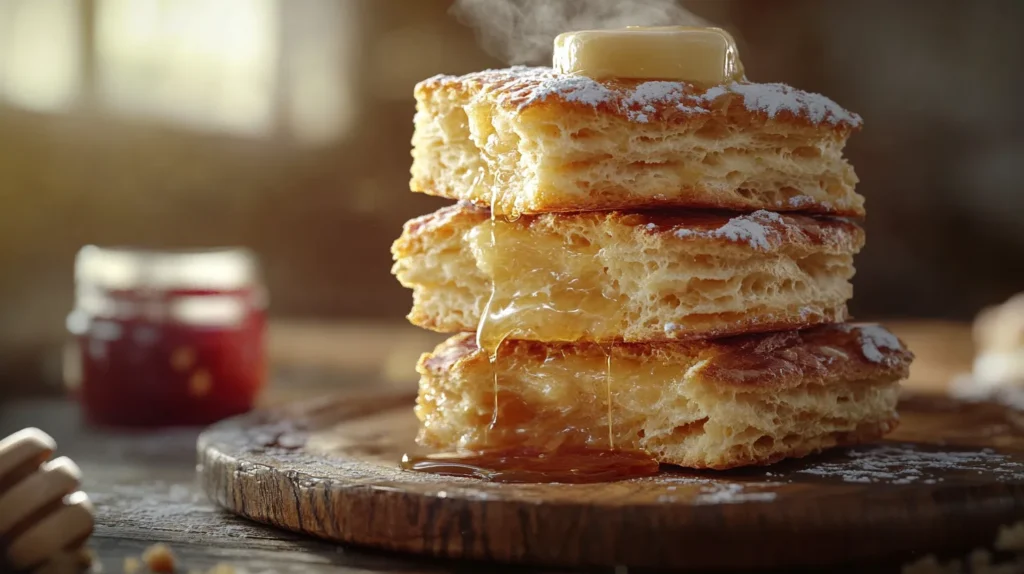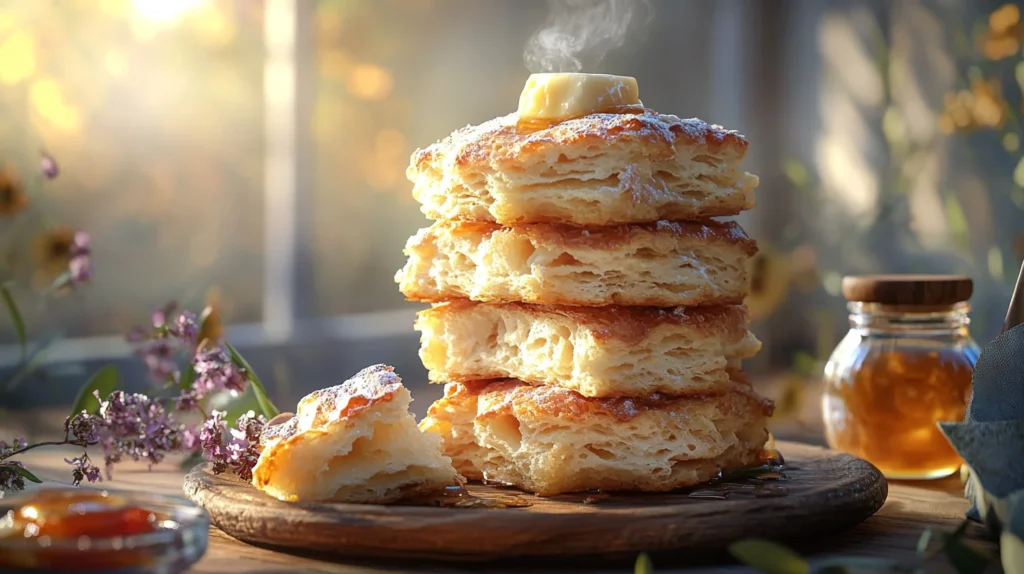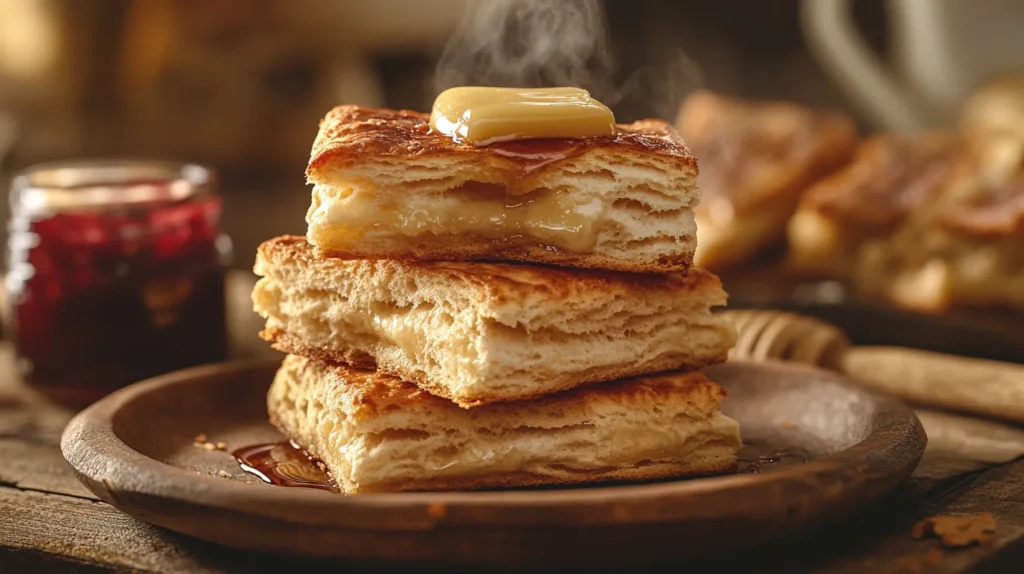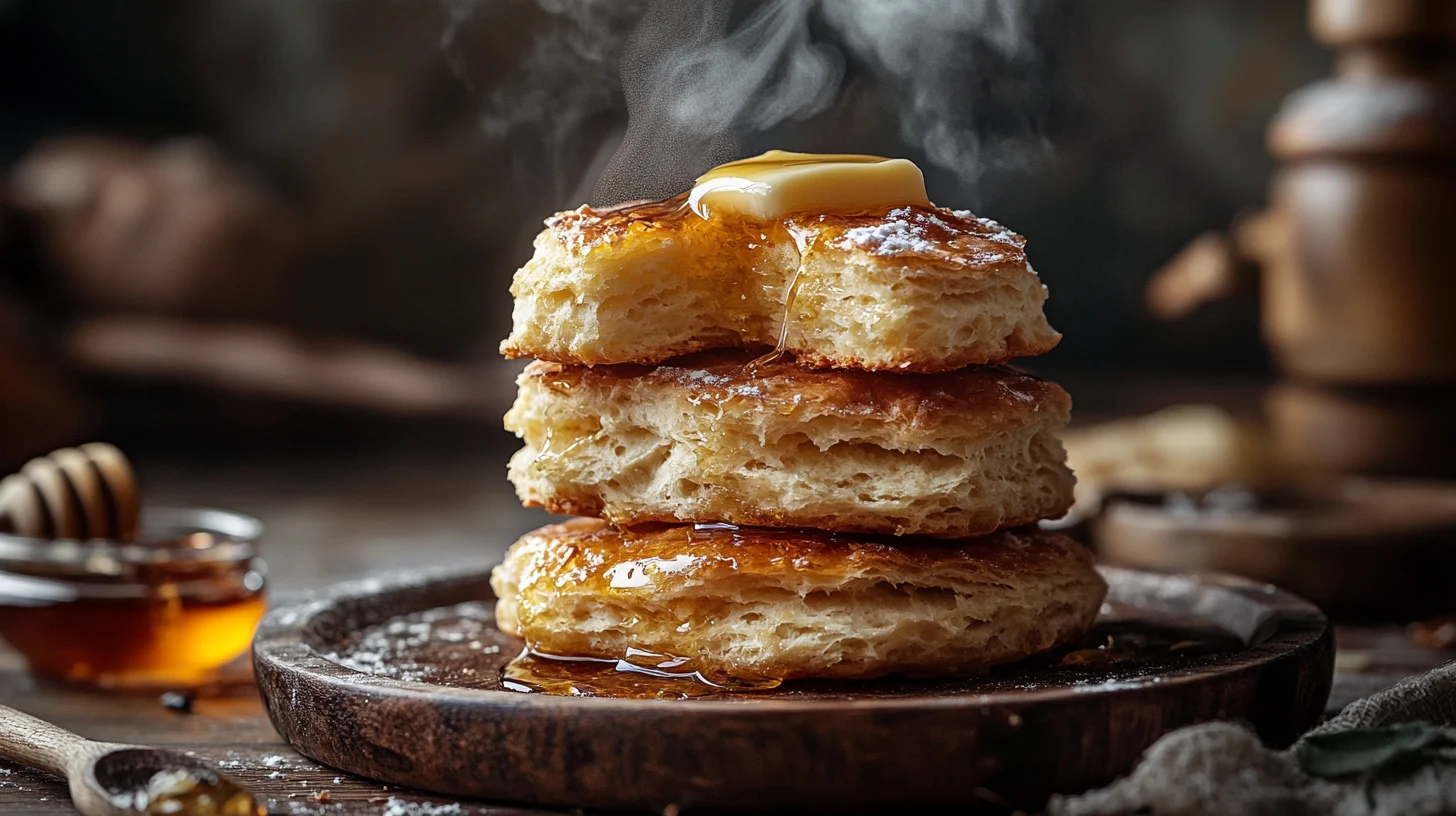When it comes to comfort food, few things can rivals the delightful experience of biting into a warm, flaky biscuit. Among all variations, Flaky Mile High Biscuits stand out for their lofty rise and irresistible texture. These biscuits promise to transport you to a cozy kitchen filled with the aroma of freshly baked goods, where every bite is a heavenly indulgence. In this comprehensive guide, we will delve into the art and science behind achieving that perfect flaky biscuit at home, ensuring that you’ll be able to impress family and friends alike.
Understanding the Science of Flaky Biscuits
Creating Flaky Mile High Biscuits isn’t just about following a recipe; it’s about understanding the intricate dance of ingredients and techniques that lead to that elevated, buttery flake. The key lies in the science behind each component, from the choice of fat to the temperature of your ingredients.

The Role of Fat: Choosing the Right Fat and Techniques for Incorporation
Fat plays a critical role in the biscuit-making process. Not only does it contribute to flavor, but it also affects the texture. The most common fats used are butter, shortening, or lard. Each type has its unique attributes, impacting the biscuit’s final outcome.
Butter is often preferred for its rich flavor and ability to create a tender texture. When incorporating butter, it’s crucial to keep it cold. You can achieve this by using a grater or cutting the cold butter into small pieces before mixing it with the flour. This method helps to create pockets of fat within the dough, which will melt during baking and create that characteristic flaky layer.
On the other hand, lard or shortening can produce an even flakier result due to their higher fat content. However, some bakers prefer the taste of butter, so it ultimately comes down to personal preference. Experimenting with different fats and their combinations can yield exciting results, and could bring you closer to your ideal Flaky Mile High Biscuits.
The Importance of Cold Ingredients: Why Cold Butter and Buttermilk are Crucial
Just as important as the type of fat is the temperature of your ingredients. Cold butter and chilled buttermilk are vital for creating biscuits with height and flakiness. When the cold fat interacts with the flour and then melts during baking, it creates steam, lifting the layers of dough and resulting in a tall biscuit.
To ensure your butter stays cold, consider keeping it in the freezer until you’re ready to use it. Additionally, using cold buttermilk not only adds moisture but enhances the biscuit’s flavor profile. This combination of cold ingredients and quick mixing helps to prevent gluten development, which can lead to tough biscuits rather than the light, airy texture we desire.
Flour Power: Selecting the Best Type of Flour for Maximum Flake

The choice of flour significantly influences the structure and texture of Flaky Mile High Biscuits. All-purpose flour is typically recommended because it strikes the perfect balance between protein content and tenderness. However, some bakers prefer to incorporate a touch of cake flour to help achieve that extra fluffiness.
It’s worth noting that the way you handle flour matters as well. Sifting the flour before measuring can aerate it, leading to better results. Moreover, minimizing the amount of handling after mixing is essential to avoid developing excess gluten, which would result in denser biscuits instead of the desired flaky variety.
Step-by-Step Guide to Perfect Mile High Biscuits
Now that we’ve covered the foundational principles behind making Flaky Mile High Biscuits, it’s time to put theory into practice. Below, we’ll provide a detailed step-by-step guide that will take you through the entire biscuit-making process from start to finish.
Gathering Your Ingredients: A Comprehensive Checklist
Before diving into the world of biscuit-making, having all the necessary ingredients within arm’s reach is essential. Here’s a checklist of what you’ll need:
- All-purpose flour
- Baking powder
- Salt
- Cold unsalted butter
- Cold buttermilk (or milk with vinegar)
- Optional add-ins such as cheese, herbs, or sugar for sweet biscuits
Having these ingredients prepared will enable a smoother baking experience, allowing for quick mixing and minimal downtime. The beauty of Flaky Mile High Biscuits is that they are versatile, meaning you can easily modify the recipe to suit your taste preferences.
The Cutting Technique: Mastering the Biscuit Cutter for Even Baking
One of the keys to achieving uniform biscuits lies in mastering the cutting technique. Using a biscuit cutter is ideal since it creates clean cuts, helping to maintain the integrity of the dough.
When cutting the biscuits, press straight down without twisting. Twisting can seal the edges of the biscuit, preventing it from rising properly. If you don’t have a biscuit cutter, a sharp knife will work too. Aim for consistent thickness across all biscuits, ideally around one inch, to ensure even baking.
After cutting, place the biscuits on a baking sheet lined with parchment paper. They can be placed close together for soft sides or spaced apart for crispier edges. Either way, make sure they’re facing up to allow maximum rising potential during baking.
Baking the Biscuits: Oven Temperature, Baking Time, and Monitoring for Doneness
Baking is where the magic happens! Preheat your oven to a high temperature, typically around 425°F (220°C). The heat helps the cold fat to melt quickly, creating steam that lifts the biscuits.
Once your oven is preheated, bake the biscuits for about 12-15 minutes or until they are golden brown. Keep an eye on them as they bake to avoid overcooking, which can lead to dry biscuits. You want the tops to be beautifully browned while maintaining a tender interior.
As a tip, rotating the baking sheet halfway through cooking can ensure even browning. Once done, let them cool slightly before serving. Enjoy the tantalizing aroma and visual appeal of your freshly baked Flaky Mile High Biscuits!
Cooling and Serving: How to Preserve Flaky Texture
Cooling is an often overlooked aspect of biscuit enjoyment. Allowing the biscuits to cool on a wire rack instead of leaving them on the hot baking sheet helps prevent steaming, which can lead to sogginess.
When serving, these biscuits can be enjoyed plain, slathered with butter, or paired with jams and honey. For savory applications, consider serving them alongside soups or stews, where their flaky texture complements the broth perfectly.
Also, experimenting with toppings can elevate your biscuit experience. From garlic herb butter to whipped cream and fresh fruit for sweet variants, the possibilities are endless. Embrace creativity in presentation and flavor pairing to make your biscuits truly unforgettable.
Troubleshooting Common Biscuit Problems
Even experienced bakers face challenges when creating Flaky Mile High Biscuits. To help you navigate common issues, we’ll explore solutions to frequent problems encountered during the biscuit-making journey.
Dense Biscuits: Identifying and Fixing Causes of Dense Texture
If your biscuits come out dense rather than light and flaky, several factors might be at play. One primary culprit could be overmixing the dough. Gluten develops when flour is combined with liquid; excessive mixing can lead to tough, chewy biscuits.
Another common issue is insufficient leavening agents. Make sure that your baking powder is fresh and properly measured to ensure adequate lift while baking. Always double-check expiration dates on your baking supplies; stale ingredients lead to disappointing results.
Finally, the quality of your flour can affect the final product. Consider sifting your flour or opting for a different brand if you consistently struggle with density. With a little experimentation, you should find a suitable combination that yields fluffy results.
Tough Biscuits: Common Mistakes and Solutions for Achieving Tenderness
Tough biscuits can stem from various mistakes, including using too much flour or inadequate fat incorporation. It’s essential to measure flour accurately—spoon it into your measuring cup and level off to avoid packing it too tightly.
Incorporating fat correctly is also crucial. Be cautious not to overwork the butter into the flour. Instead, leave small chunks of butter intact. These chunks will melt during baking, creating desirable flaky layers.
Lastly, always remember to use chilled ingredients and minimize handling. Tenderness is achieved through careful management of your biscuit dough, so approach mixing and shaping with a gentle touch.
Soggy Bottoms: Preventing Soggy Biscuits Through Proper Baking Techniques

Soggy bottoms can be frustrating, but they can often be avoided with proper techniques. First, ensure your baking sheets are preheated if using a metal pan. A hot surface can help set the bottom of the biscuit quickly, reducing the chances of sogginess.
Additionally, consider adjusting your oven rack position. Placing the baking sheet in the center allows for optimal heat circulation, promoting even baking. If you notice that the bottoms are still soggy after adjusting these elements, try increasing the baking time slightly or lowering the temperature for the last few minutes to allow thorough cooking without burning the tops.
Variations and Creative Applications
While the classic Flaky Mile High Biscuits are irresistible as they are, exploring variations can add an exciting twist to your baking repertoire. Let’s dive into some creative applications and adaptations to cater to different tastes.
Sweet Biscuits: Adding Sugar and Flavorings for Dessert Biscuits
Transforming your biscuits into a sweet treat is easier than you might think. By adding sugar to the dough, you can create a delightful base for dessert biscuits. Start with a simple increase in sugar, and feel free to experiment with additional flavorings like vanilla extract or citrus zest.
For added flair, consider incorporating mix-ins such as chocolate chips or dried fruits. Once baked, drizzle with icing or serve alongside fresh fruit for a delicious brunch option. Sweet biscuits offer an inviting alternative to traditional desserts, showcasing versatility in your baking.
Savory Biscuits: Incorporating Herbs, Cheese, and Other Savory Ingredients
Savory variations of Flaky Mile High Biscuits can be just as enticing as their sweet counterparts. Adding herbs like rosemary, thyme, or chives to the dough provides an aromatic twist. Similarly, incorporating shredded cheese brings richness and depth to each bite.
You can also experiment with spices or cooked bacon bits for a hearty touch. These savory biscuits pair wonderfully with soups or can be served alongside breakfast dishes for a satisfying start to the day. Don’t hesitate to get creative with flavor combinations that resonate with your palate.
Beyond the Basic Biscuit: Exploring Different Shapes and Sizes
Who says biscuits have to be round? Exploring different shapes and sizes can add a playful element to your baking. Use cookie cutters to create fun shapes for special occasions. Alternatively, you might choose to make larger, skillet-style biscuits for a family feast.
You can also experiment with layering and filling techniques. By rolling out the dough and folding it with your favorite fillings—such as sweet cinnamon-sugar mixtures or savory cheese spreads—you can create visually appealing and delicious stuffed biscuits.
Conclusion: Enjoying the Perfect Flaky Mile High Biscuit
Baking the perfect Flaky Mile High Biscuits is both an art and a science, requiring attention to detail and a willingness to learn from mistakes. By understanding the roles of your ingredients, mastering techniques, and troubleshooting common issues, you can create biscuits that are not only sky-high but also bursting with flavor and texture.
As you embark on your biscuit-making journey, embrace creativity and adaptation. Whether whipping up traditional recipes or venturing into new flavors and forms, the joy of baking reaches its peak when shared with loved ones. So roll up your sleeves, gather your ingredients, and enjoy the delightful experience of crafting flaky, delicious biscuits right in your own kitchen. Happy baking!
For more recipes please click on below links:
Dive into Branzino Meat: Explore its Flavor and Culinary Versatility
Easy Eggless Sausage Hashbrown Breakfast Casserole Recipe – Make Mornings Delicious and Hassle-Free

